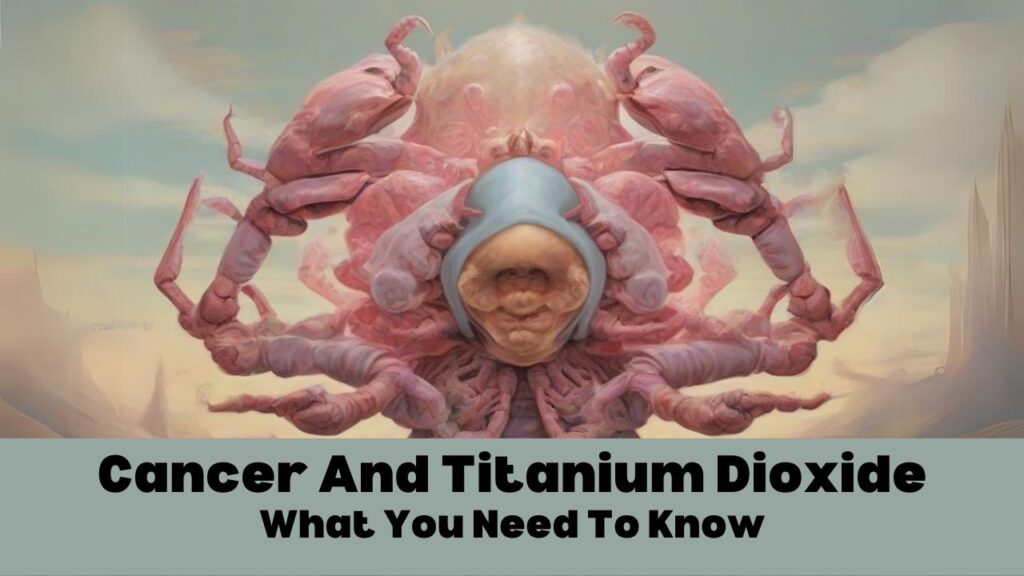Cancer And Titanium Dioxide: In our modern world, where technology has become an essential part of our everyday lives, there is an increasing focus on the safety of the materials we encounter regularly. One material that has attracted attention in discussions related to health and safety is titanium dioxide. So, let’s dive into the connection between cancer and titanium dioxide, aiming to provide you with a better understanding of the topic and important insights for your well-being.
What is titanium dioxide?
Titanium dioxide is a naturally occurring oxide of titanium that is commonly used as a white pigment in various industries. It is a versatile ingredient found in products like paints, cosmetics, and food items. It has the remarkable ability to reflect and scatter light, making it indispensable for creating vibrant colors and enhancing the opacity of materials.
The role of titanium dioxide in daily life

Before we explore the potential links between titanium dioxide and cancer, let’s appreciate how prevalent it is in our surroundings. You can commonly find titanium dioxide in paints and coatings, where it enhances brightness and durability. It is also widely used in cosmetics to provide opacity and color to various beauty products. Additionally, it serves as a food additive, making certain items whiter and brighter. Furthermore, titanium dioxide plays an important role in sunscreen, providing effective UV protection.
Concerns about Cancer And Titanium Dioxide
Now, let’s address the concerns surrounding the safety of titanium dioxide and its potential link to cancer. Recent debates have focused on the possibility of health risks from inhaling high concentrations of titanium dioxide nanoparticles, especially in occupational settings. These concerns have sparked discussions about the safety of consumer products containing this compound.
Taking a scientific perspective – Cancer And Titanium Dioxide
It is crucial to approach this topic with a scientific lens. Most studies indicating potential risks are based on experiments conducted on animals or cells in controlled laboratory environments. Translating these findings into real-world situations involves considering a complex set of variables and often requires further research.
Assessing the risks – Cancer And Titanium Dioxide

Government health agencies and regulatory bodies, such as the U.S. Environmental Protection Agency (EPA) and the European Food Safety Authority (EFSA), play a crucial role in evaluating the risks associated with substances like titanium dioxide. Currently, these agencies maintain that titanium dioxide, when used within specified limits, does not pose a significant threat to human health.
Reducing potential risks: Cancer And Titanium Dioxide
To address potential concerns, some manufacturers have explored alternatives and created products with reduced nanoparticle content. Additionally, implementing occupational safety measures, such as proper ventilation and the use of personal protective equipment, can greatly minimize exposure for those working in industries where titanium dioxide is commonly used.
Ensuring your safety
As an informed consumer, it is important to stay updated and make conscious choices. Reading product labels, understanding the purpose of titanium dioxide in a product, and being aware of potential alternatives can empower you to make decisions aligned with your safety preferences.
Sunscreen considerations: Cancer And Titanium Dioxide
For those worried about titanium dioxide in sunscreens, it’s important to note that the benefits of sun protection generally outweigh the potential risks. Choosing broad-spectrum sunscreens with sufficient UVA and UVB protection can help address concerns while safeguarding your skin from harmful rays.
Occupational safety measures
If you work in an industry where exposure to titanium dioxide is possible, following occupational safety guidelines and utilizing recommended protective gear can significantly minimize any potential risks. By prioritizing safety measures, you can protect yourself while carrying out your work responsibilities.
Remember, knowledge and awareness are key to making informed choices and ensuring your well-being.
Frequently Asked Questions About Cancer And Titanium Dioxide
1. Is titanium dioxide safe in cosmetics?
Yes, when used within regulatory limits, titanium dioxide is considered safe in cosmetics. The FDA regulates the use of this compound in cosmetic products to ensure consumer safety.
2. Can titanium dioxide in sunscreen cause cancer?
Current scientific evidence suggests that titanium dioxide in sunscreens, when used as directed, does not pose a significant cancer risk. It is a crucial component for protecting the skin from harmful UV rays.
3. Are there alternative products without titanium dioxide?
Yes, some products are formulated without titanium dioxide for individuals who prefer alternatives. Checking product labels and exploring options can help you find suitable alternatives.
4. How can I minimize exposure to titanium dioxide?
To minimize exposure, consider using personal protective equipment if you work in an industry where titanium dioxide is present. Additionally, choose products with lower nanoparticle content when possible.
5. What do regulatory agencies say about titanium dioxide safety?
Regulatory bodies like the EPA and EFSA affirm that titanium dioxide, within specified limits, is safe for use in various products. Regular assessments are conducted to ensure ongoing safety.
Conclusion of Cancer And Titanium Dioxide
In conclusion, the connection between cancer and titanium dioxide is a nuanced topic that requires careful consideration. While concerns exist, especially in occupational settings with high exposure levels, regulatory bodies, and scientific evidence generally support the safety of titanium dioxide when used within established guidelines. As a consumer, being informed about the products you use and understanding the context of potential risks is crucial for making empowered choices.
By navigating this landscape with knowledge and discernment, you can strike a balance between enjoying the benefits of modern products and ensuring your safety.
Key Takeaways:
- Titanium dioxide is a versatile compound widely used in various industries.
- Concerns about its potential link to cancer exist, primarily in occupational settings with high exposure levels.
- Scientific evidence and regulatory assessments generally support the safety of titanium dioxide within specified limits.
- Informed consumer choices and adherence to safety guidelines can help mitigate potential risks.






Pingback: Titanium Dioxide In Tampons: The Remarkable Truth Revealed - Safe Climber Overseas Pvt. Ltd.